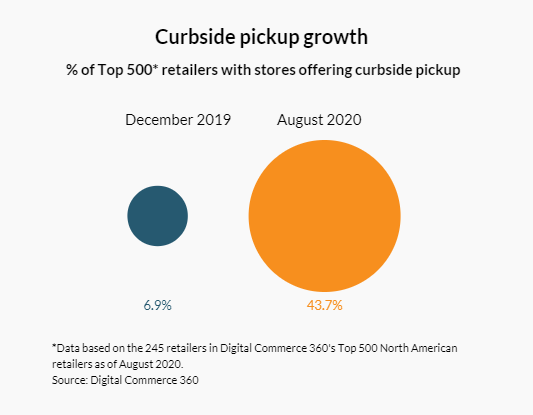3 Reasons This Peak Season is Different (and How to Win)

As we head into this year’s holiday season, things are gearing up to be a little different. Due to supply chain disruptions throughout the year, what we’d usually call “peak season” has already started.
Holiday sales typically represent about a fifth of annual sales for retailers. Some online sellers make as much as 30% of sales during the 4th quarter each year. Whether this has been a great year or a difficult one, you can’t afford to miss out on the biggest opportunity that’s existed in years.Accompanying this sales growth is high demand, increased competition, product shortages, and exposed weaknesses in current processes. Many ecommerce merchants are still suffering from breakages in the supply chain and loss in labor due to COVID-19 safety measures—issues that could hold them back as online shopping goes further into overdrive this holiday season.
Here’s why this year’s holiday season is different and what sellers need to do to ensure a successful Q4.
Why Is This Peak Season Different Than Previous Years?
At the height of the coronavirus pandemic, U.S. consumers spent a record-breaking $200 billion in Q2 alone – up 44% year over year. Ecommerce sales represented 20.8% of all retail sales up from 14.7% in the same period in 2019. The online buying trend has continued. In the last 12 months leading up to the end of May, Amazon marketplace sellers averaged $160,000 in annual sales compared to $100,000 the year prior.
Brick and mortar stores generally keep inventory low to avoid tying up cash in products that aren’t selling as quickly as in previous years. This might mean retail locations could sell out more quickly, driving even more people online. It could add up to a record-breaking year for online sellers.

Another thing that ecommerce experts predict is more returns. When people buy online, they can’t try things or see exactly how things look or feel in real life. Returns have always been higher for online retailers. Returns for eCommerce stores can average as high as 30% of purchases – more than 3X brick and mortar stores.
With additional buying will come additional returns. That could create a larger strain on inventory and profits. The Reverse Logistics Association estimates that the return and repair process accounts for 10% of total supply chain costs.
Managing inventory and returns efficiently needs to be an even bigger priority in 2020.
3 Reasons This Peak Season is Different:
- Coronavirus has changed the way people shop. Ecommerce has dominated retail sales, leaving merchants with the task to keep inventory counts accurate and adjust their processes to meet new consumer demands (BOPIS, contactless pickup/delivery).
- Increased online demand means there is now an even greater need to improve your online store. While there are merchants who may survive despite a subpar website, this peak season will reveal any cracks in online operations.
- A constant peak season means you’ll need to escalate your efforts to keep information up to date, provide clear communication to customers, and be able to respond to emerging opportunities.
How to Win This Year’s Peak Season
Winning this year’s peak season means taking action right now to make sure you’re ready. If you don’t have a robust end-to-end solution for your inventory management and online store to manage all of your sales channels, you’re putting your business at risk.
Did you know the average retailer can have inaccurate stock counts as much as a third of the time? Think of all the lost sales opportunities or frantic pick sessions looking for stock that can’t be accounted for.
1. Keep accurate inventory counts
One of the keys to maintain the right stock levels is forecasting. Yet 73% of retailers report that forecasting is a constant issue. In the same study, nearly two-thirds (65%) said the inability to accurately track inventory was a major issue. It’s not much of a leap to believe these two factors are related.
The right Inventory Management System (IMS), such as SkuVault, will help you manage the increased demand and make sure you have the right amount of inventory on the shelves.
SkuVault makes sure your inventory is accurate and synced across every sales channel, platform, and marketplace. This avoids oversells and disappointed customers. Robust reporting functions, such as the Replenishment Report, remind you to reorder in time to anticipate demand, while still maintaining the right amount of safety stock until new product arrives.2. Improve your online store with an ecommerce platform
A website that isn’t up to the standards of modern shopping will lead to breakages, downtime, missed sales opportunities, and lost revenue. To thrive, sellers need to be able to count on their website 365 days a year and invest in an online presence that offers a clear path to purchase and an enjoyable buying experience.Instead of taking a reactive approach and scrambling to fix things that go wrong, online sellers need to be proactive about the health and efficacy of their websites. Look for ways to optimize your entire shopping experience and engage shoppers for the long-term rather than just making short-term, temporary fixes.
Many businesses shy away from changing how things are done, especially during peak season. The reality is that things won’t be slowing down anytime soon. There won’t be a convenient time to make improvements, even after the holiday rush. Now is the time to take the necessary steps to improve your business’ online presence.
Forward-thinking businesses across many industries are quickly transforming their business, moving their operations online and automating their key processes. Those who can quickly adapt their business will be the most equipped to thrive now and in the long term.
3. Keep information up-to-date
Changing expectations and supply chain disruption mean your business cannot be bogged down by issues like rising overhead and maintenance costs and hard-to-manage systems.You need a website that enables you to react to disruption, changing customer needs, and new opportunities. Retailers and wholesalers alike can empower their teams during any season by automating time-consuming processes. Shifting to a digital-forward model frees up your staff to focus on what truly matters: nurturing your customer relationships, creating a spectacular end-to-end brand experience, and finding new business opportunities.
Conclusion
Now is the “moment of truth” for online merchants. Even if your store conquered past peak seasons, resting on your laurels won’t hold up in this new ecommerce climate of high demand, supply chain uncertainty, and increasing competition. It’s no longer just about preparing for peak season—it’s about building up your business to thrive in any season.
This starts with getting your ecommerce platform and inventory management operations in order and innovating your online presence. Merchants who do so will be able to maximize sales, manage their fulfillment processes, and keep strong relationships with their customers during peak season and beyond.
